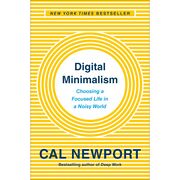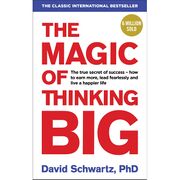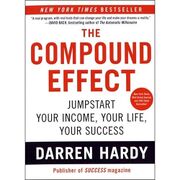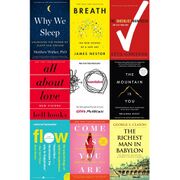Four Thousand Weeks
🍎 Healthy brain food
"Any finite life—even the best one you could possibly imagine—is therefore a matter of ceaselessly waving goodbye to possibility."
— Oliver Burkeman, Four Thousand Weeks (2021)
Introduction
| Four Thousand Weeks | |
|---|---|
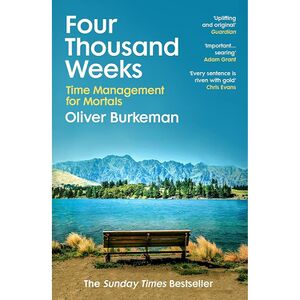 | |
| Full title | Four Thousand Weeks: Time Management for Mortals |
| Author | Oliver Burkeman |
| Language | English |
| Subject | Time management; Philosophy; Happiness; Personal development |
| Genre | Nonfiction; Self-help |
| Publisher | Farrar, Straus and Giroux |
Publication date | 10 August 2021 |
| Publication place | United States |
| Media type | Print (hardcover, paperback); e-book; audiobook |
| Pages | 288 |
| ISBN | 978-0-374-15912-2 |
| Goodreads rating | 4.2/5 (as of 6 November 2025) |
| Website | oliverburkeman.com |
📘 Four Thousand Weeks is a 2021 nonfiction book by Oliver Burkeman, published by Farrar, Straus and Giroux on 10 August 2021, which reframes time management around human finitude.[1] It rejects the goal of getting “everything done” and warns of an “efficiency trap,” offering practical ways to choose what matters instead of chasing ever-rising throughput.[2] The book is arranged into two parts—“Choosing to choose” and “Beyond control”—across fourteen chapters, with an appendix of “Ten tools for embracing your finitude.”[3] Reviewers describe the prose as plainspoken and wry; one called it “full of … sage and sane advice” delivered with “dry wit.”[4] The publisher reports it as an instant New York Times bestseller in the United States.[1] In the United Kingdom, the Penguin/Vintage edition was billed as an instant Sunday Times bestseller, and the book appeared in TIME’s “100 Must-Read Books of 2021” and the Financial Times year-end critics’ picks.[5][6][7]
Chapter summary
This outline follows the Farrar, Straus and Giroux hardcover edition (10 August 2021; ISBN 978-0-374-15912-2).[8]
I – Choosing to Choose
🧗 1 – The Limit-Embracing Life. Before mechanical clocks and factory whistles, a peasant in early-medieval England worked by the sun and the task—ploughing when the soil was ready, harvesting as grain ripened, pausing when bells called to worship—without treating time as a ledger of hours. Historians later showed how industrial capitalism replaced this task-orientation with clock time; what mattered became shifts, schedules, and “saving” or “wasting” minutes. That shift seeded the modern anxiety of “too much to do,” as if life were a conveyor belt of slots to be filled correctly. The fantasy of a future day when the inbox is empty and the calendar clears keeps attention in limbo and makes the present feel like a staging area. The counter-move is to let finitude be the starting condition rather than a problem to solve. Choosing a few commitments implies declining many others, and the refusals are not failures but the cost of depth. This stance swaps infinitude’s mirage for a workable day. Control comes less from acceleration than from narrowing the field. This practice is a limit-embracing life that works with a fixed allotment instead of fighting it; by narrowing the field and treating refusals as the cost of depth, a workable day emerges.
⚙️ 2 – The Efficiency Trap. In 1955, the British historian C. Northcote Parkinson quipped in The Economist that “work expands to fill the time available,” illustrating with a bureaucracy that grew even as fleets and colonies shrank. Personal workflows behave the same way: reply faster and the inbox breeds more replies; process more tasks and the list multiplies. Efficiency invites extra demand until gains vanish, a rebound familiar in economics since William Stanley Jevons’s 1865 observation that better engines increased total coal consumption. Because modern “everything” is effectively infinite, optimizing tools only scale the flood and push peace of mind into the future. Waiting to “clear the decks” defers life to a horizon that never arrives. Relief comes from doing fewer things to completion rather than cramming more into the day. That means disappointing some people on purpose and treating busywork as optional. By narrowing scope, you trade the fantasy of total control for the reality of enough. Limits—not throughput—make a day livable.
⏳ 3 – Facing Finitude. In 1927, Martin Heidegger’s Being and Time framed human existence as finite and “being-toward-death”: we don’t possess time from outside it; we are the time we have. Seen this way, a life is not something to schedule from above but a path formed by choices that close other paths. Every decision—study this field, move to that city, raise a family—creates the person who then has fewer, not more, possibilities, which is how reality works. Anxiety spikes when we refuse this bind and try to preserve every option, spreading ourselves thin across half-started projects. The honest relief comes after an irreversible choice, when attention can settle and work deepen. Regret remains, but it is the price of seriousness rather than a sign of failure. Practically, choose a small set of commitments and let the “no” to everything else stand. Doing so converts time from a hostile scarcity into a medium you can inhabit. Facing finitude is how meaning arises, because limits give significance its shape.
🐢 4 – Becoming a Better Procrastinator. A widely circulated story about investor Warren Buffett describes him advising a longtime pilot to list his top twenty-five career goals, circle the five that mattered most, and treat the remaining twenty as a hard “avoid-at-all-costs” list—a concrete exercise in deciding what to neglect so the important work can proceed. That stance becomes everyday practice: schedule time for what matters before the day fills, like “paying yourself first” with money. Start with a single meaningful task when willpower and attention are least fragmented. Narrow scope by limiting active projects; juggling too many creates a permanent state of half-finished efforts and displaced anxiety. This scatter reflects a human tendency to flee discomfort by switching tasks the moment things feel uncertain or boring. Settling—committing to one path knowing others will close—frees depth rather than constrains it. The rhythm is small, repeated appointments with priority work, protected on the calendar like any meeting. Saying no becomes an operating rule rather than an emergency measure. Procrastination isn’t abolished; it is steered, with the right things neglected so the important can proceed. Accept that most possibilities will remain undone, and focus follows from deliberate exclusions.
🍉 5 – The Watermelon Problem. On 8 April 2016, two BuzzFeed staffers live-streamed a slow spectacle on Facebook—stacking rubber bands around a watermelon while wearing safety goggles—drawing roughly 800,000 concurrent viewers over about forty-four minutes before the fruit finally burst. The event trended across platforms and spawned copycats, not because it was important but because it weaponized suspense and social proof in a feed designed to keep eyes from looking away. The sequence shows how attentional capture works: novelty, countdown tension, and the promise of a payoff at an unpredictable time. Life, in practice, is the sum of what receives attention; minutes surrendered to manufactured curiosity are minutes of living surrendered. Because attention is finite, every scroll trades against conversations, craft, or rest that would otherwise fill those same moments. The pull of trivial content isn’t new, but the current attention economy industrializes it with metrics, autoplay, and infinite scroll. The remedy is not heroic self-control but intentional constraints: decide in advance where attention may go, design frictions that make drifting less likely, and give valued activities protected, device-free time. Choose boredom long enough to pass through the urge to switch; meaningful work then becomes absorbing again. Treat attention as life’s raw material; with limited weeks, choose which experiences deserve it, and use constraints to keep them.
📱 6 – The Intimate Interrupter. Poet Mary Oliver coined the phrase “the intimate interrupter” in her essay “Of Power and Time” (collected in Upstream, 2016) to describe the inner voice that derails concentration from within, long before external pings arrive. The deepest distractions are self-generated—restlessness, self-critique, and the itch to check anything—because beginning real work exposes uncertainty and the risk of falling short. Instead of pathologizing this discomfort, treat it as the entry toll for meaningful focus. Brief, deliberate exposure helps: sit with the urge to flee, breathe, and do the next small unit of the task without negotiation. Physical changes reinforce the stance—single-tasking in a plain environment, silenced notifications, and short, timed blocks that end before willpower collapses. Naming the inner interrupter reduces its power; expecting it prevents panic when it arrives. The same discipline applies to leisure: depth in a walk, a book, or a conversation requires tolerating the first few minutes of fidgeting. Over time, attention strengthens not by perfect control but by practicing return. Because time is finite, accepting this discomfort opens the only route to experiences that matter.
II – Beyond Control
🕰️ 7 – We Never Really Have Time. Cognitive scientist Douglas Hofstadter’s 1979 formulation—“Hofstadter’s Law,” coined in Gödel, Escher, Bach—captures the way even padded estimates collapse, because tasks almost always take longer than we expect, even when we account for that fact. Psychologists call this the planning fallacy, a bias that seduces people into optimistic timelines and then punishes them with overruns and stress. An intimate family story drives the point home: a grandmother who escaped Germany before Hitler’s worst atrocities bequeathed meticulous contingency-planning—leaving absurdly early for flights to beat uncertainty—yet airports still delivered surprise traffic jams and closed security lanes. Planning cannot wrest control from an inherently uncontrollable future. The deeper trap is the anxious demand for reassurance that tomorrow will unfold as desired; worry loops arise when the mind tries to manufacture certainty the future can’t supply. Plans still matter, but they work best as present-moment intentions rather than contracts the future must honor. Seen this way, “time” isn’t a possession to stockpile but the medium we inhabit, and treating it as a hoardable resource only intensifies scarcity. Relinquish the fantasy of future mastery and act in the only time you can touch—the present. Abandoning the demand for reassurance defuses anxiety and frees attention for what matters now.
📍 8 – You Are Here. In London’s British Museum, visitors filming the Rosetta Stone on their phones “to look at later” exemplify a modern reflex: exchanging presence for potential future use. That habit scales into the “when-I-finally” mindset—when I finally clear my inbox, find the right partner, win the election, or fix myself, then life can begin—so today becomes mere transit to a fantasized tomorrow. Money metaphors like the “billable hour” reinforce the notion that moments exist to be converted into later value, not lived for their own texture. Parenting debates dramatize the same mistake: whether “Baby Trainers” (strict schedules) or “Natural Parents” (ever-responsive routines), both camps can treat the present as training for a child’s future utility. Writer Adam Gopnik names this the “causal catastrophe,” the belief that the proof of a childhood’s worth lies solely in the adults it produces—thereby draining childhood of intrinsic value. To counter that drift, treat ordinary acts as if this instance might be your last time doing them; sooner or later, it will be. Presence isn’t an achievement to grind toward; it is what remains when bargaining with an imaginary future stops. Relocate meaning from a fantasized “later” to the irreducible now. Refusing to instrumentalize moments restores their value and makes time lived rather than leveraged.
🛌 9 – Rediscovering Rest. On a boiling summer weekend, a gathering of the “Take Back Your Time” campaign pressed a radical point: leisure shouldn’t have to justify itself by boosting Monday’s productivity. That pressure explains why “time off” so easily becomes a workout for work—reading to upskill, napping to bounce back, vacations optimized into itineraries—until rest is just labor’s pit stop. Older wisdom cut the opposite way: in Latin, negotium (business) literally means “not-leisure,” implying that work is the exception and leisure the point. Mid-century philosopher Josef Pieper made the same case in Leisure: The Basis of Culture: true leisure is receptive contemplation, not recovery for more output. Practically, reclaim “atelic” activities—hiking, conversation, music, tinkering—done for their own sake, with no goal beyond the doing. Paradoxically, abundance can worsen the problem: more free-time options heighten the urge to optimize every hour, so even weekends feel graded. Many people also suffer idleness aversion, the inability to rest without guilt, because they secretly believe usefulness is the measure of a life. De-instrumentalize nonwork so leisure resumes its role as an end, not a tool. Choosing atelic activities trains attention to dwell in time as it is, which anchors the broader theme that embracing finitude—not pursuing control—restores meaning.
🌀 10 – The Impatience Spiral. In New York or Mumbai, a blare of car horns does nothing to move traffic; it only broadcasts a futile demand that reality speed up to suit the honker. That sound captures a familiar pattern: each technological gain—faster downloads, shorter queues, one-click anything—ratchets expectations that the world should yield instantly, so any pause feels like an affront. Taoist images from the Tao Te Ching—water flowing around a rock, a reed bending in wind—offer a corrective, because events take the time they take no matter how intensely we push. The more we hurry to outrun delay, the more errors and irritations we generate, which in turn provoke more hurrying: impatience becomes a self-reinforcing loop. Even reading exposes the truth, because pages won’t compress to the tempo of a mood; attention must stretch to a book’s pace. What looks like “efficiency” often masks an addiction to acceleration that society rewards as being “driven,” though it leaves people brittle and resentful. There’s relief in relinquishing tempo control and working with time’s grain—choosing to wait, to queue, to draft carefully—so results emerge when they’re ready. The move is to trade the fantasy of mastery for the practice of patience, which returns attention to the only moment anyone can inhabit. Interrupt the loop—spot the flare of urgency, let it pass, proceed at a humane pace—and accepting finitude becomes the surest route to a meaningful life.
🚌 11 – Staying on the Bus. In 2004, Finnish-American photographer Arno Rafael Minkkinen told graduates at the New England School of Photography to picture Helsinki’s main bus station with roughly two dozen platforms; for the first miles, many routes share the same stops, so early work looks indistinguishable from everyone else’s, and the temptation is to jump off, run back, and start over. The counsel is stranger and wiser: stay on the bus until the lines diverge and the scenery changes, because distinctiveness appears only after the tedious, derivative phase. That discipline rests on three practical habits: develop a taste for problems instead of resenting them, embrace “radical incrementalism” by doing modest daily chunks and stopping when the time is up, and tolerate the long apprenticeship where your path mirrors others’. Quitting when boredom bites or novelty beckons resets you to the crowded part of the map, so every restart costs compounding progress. The metaphor dignifies slow accumulation—drafts, iterations, patient re-work—over spasms of heroic effort that burn out and begin again. It also reframes frustration as evidence you’re far enough along for real work to begin. Patience, not speed, is the creative leverage that lets limited days deepen rather than scatter. Sticking to small, repeatable commitments works with time’s constraints so identity and originality can cohere.
🧑💻 12 – The Loneliness of the Digital Nomad. Consider Mario Salcedo, a Cuban American financial consultant nicknamed “Super Mario,” who has spent much of the past two decades aboard Royal Caribbean ships; the schedule is his, the chores are gone, and yet his freedom floats largely apart from the people who matter to him on land. Modern myths promise that maximum personal sovereignty over hours brings happiness, but solitary control often strips time of its social texture. Traditional nomads weren’t solo wanderers with laptops; they were intensely group-bound and freer in community than any individual is alone. The important property of time here is networked, not private: days grow rich when they synchronize with others—office camaraderie, weekly choir practice, a shared Sabbath, school pick-ups that align with friends. In contrast, remote-anywhere flexibility can desynchronize you from local rhythms, making it harder to form durable ties or to be free precisely when others are free. The remedy is not another app but a willingness to yield some autonomy to common schedules and rituals, so leisure and labor overlap with the people you love. Meaning arises from coordinated attention, which requires accepting limits and letting other lives shape your own. Trading a slice of control for shared cadence turns finite weeks into lived membership instead of private management.
🌌 13 – Cosmic Insignificance Therapy. Jungian psychotherapist James Hollis recalls a patient—a vice president at a medical-instruments firm—who, while flying over the the American Midwest on a business trip and reading a book, felt the sudden clarity of “I hate my life,” a realization that her way of spending weeks no longer felt meaningful. Lockdown in New York City during the coronavirus “Great Pause” sharpened that clarity for many: hour-long commutes and staying at a desk until 6:30 p.m. to look industrious proved dispensable, while nightly applause for emergency workers and errands for housebound neighbors revealed how much care had always been there. From Ecclesiastes to now, the anxiety that toil might be “vanity” keeps recurring, yet the cosmic scale reframes it: there have always been centenarians alive alongside newborns, and from that vantage even an iPhone will be forgotten soon enough. Philosopher Iddo Landau’s point about standards helps: we don’t reject a chair because it can’t boil water, and we shouldn’t judge an ordinary life by a Michelangelo-level yardstick. Even Steve Jobs’s vow to “put a dent in the universe” looks different when measured against astronomical time. Relinquishing the demand to matter cosmically makes present-tense purposes visible again: cooking for your kids may count as much as anything can, and a novel that moves a few contemporaries can justify the effort. Accepting smallness isn’t nihilism; it is relief from self-oppression. Release yourself from impossible standards so finite time becomes a field for humane commitments rather than a test of world-historical impact. Reduced status-anxiety and perfectionism free attention to savor and serve the near-at-hand, consistent with the book’s theme of embracing finitude.
🦠 14 – The Human Disease. Zen teacher Charlotte Joko Beck provides the pivot: the condition is painful, but what makes it unbearable is the belief that there must be a cure, which is how many approach time—trying to master it so thoroughly that discomfort, regret, and risk can be eliminated. That fantasy keeps life “provisional”: we hustle to clear the decks, delay difficult choices, and keep options open so a perfected future can finally begin, even as emails multiply and opportunities expire. The result is a strategy of control that breeds anxiety—perfectionism, avoidance, and overcommitment—because every move is judged by whether it will secure a future without uncertainty. The alternative is to forgo the dream of total control and consent to reality’s limits: pick a finite set of endeavors, accept trade-offs and exposed flanks, and let relationships, projects, and seasons impose their timing. A helpful compass comes from depth psychology: ask whether a given path enlarges or diminishes you, and choose the one that entails tolerable discomfort now rather than comfortable diminishment that shrinks your days. Seen this way, finitude is not a bug to fix but the condition that makes any meaning possible. Suffering over time arises from resistance to limits; relinquishing the cure-seeking stance allows wholehearted action in the present. That shift interrupts perfectionistic loops and converts anxiety into commitment, aligning with the book’s claim that peace comes from cooperating with time rather than conquering it.
Background & reception
🖋️ Author & writing. Burkeman is a British journalist best known for his long-running Guardian psychology column, “This Column Will Change Your Life.”[9] He previously authored The Antidote: Happiness for People Who Can’t Stand Positive Thinking and has written widely for The Guardian.[10] Around publication he framed the book’s core idea as embracing limits and abandoning the urge to get everything under control—an argument that includes his now-familiar “efficiency trap.”[11] The U.S. first edition was published by Farrar, Straus and Giroux on 10 August 2021; a U.K. paperback followed from Penguin/Vintage in April 2022.[1][12] Its structure—two parts across fourteen chapters plus an appendix of “Ten tools for embracing your finitude”—leans toward reflective essays rather than a step-by-step system.[3] Reviewers often noted a plain, lightly humorous voice.[13]
📈 Commercial reception. The publisher reported the book as an instant New York Times bestseller upon its U.S. release on 10 August 2021.[1] In the U.K., Penguin promoted it as an “instant Sunday Times bestseller.”[14] It was named to TIME’s “100 Must-Read Books of 2021” on 29 November 2021 and appeared in the Financial Times “Best books of 2021: Critics’ picks” on 19 November 2021.[15][16]
👍 Praise. The The Wall Street Journal called it “provocative and appealing … well worth your extremely limited time.”[17] In the Observer, Tim Adams said it was “perfectly pitched somewhere between practical self-help … and philosophical quest.”[18] The Evening Standard praised it as a “challenging and amusing guide” to using limited time well.[19] The The Guardian highlighted its “sage and sane” counsel delivered with dry wit.[20]
👎 Criticism. Joe Moran in the The Guardian questioned how far the book would actually cure “time micro-managers,” concluding “up to a point.”[21] A later essay in The Atlantic, reflecting on the book’s influence and Burkeman’s follow-up, noted the tension in selling anti-productivity counsel in a highly packaged form, calling the enterprise “tricky.”[22]
Related content & more
YouTube videos
CapSach articles
Enjoyed this page?
📚If this page Four Thousand Weeks inspired or helped you today, a small coffee helps us keep creating and sharing more. Your support truly matters.👏
References
- ↑ 1.0 1.1 1.2 1.3 "Four Thousand Weeks". Macmillan. Farrar, Straus and Giroux. 10 August 2021. Retrieved 6 November 2025.
- ↑ Pinsker, Joe (11 August 2021). "The Best Time-Management Advice Is Depressing But Liberating". The Atlantic. The Atlantic. Retrieved 6 November 2025.
- ↑ 3.0 3.1 "Four thousand weeks: time management for mortals (eBook record)". WorldCat. OCLC. 2021. Retrieved 6 November 2025.
- ↑ Moran, Joe (1 September 2021). "Four Thousand Weeks by Oliver Burkeman review – a brief treatise on time". The Guardian. Retrieved 6 November 2025.
- ↑ "Four Thousand Weeks". Penguin Books UK. Penguin Random House UK. 7 April 2022. Retrieved 6 November 2025.
- ↑ Gutterman, Annabel (29 November 2021). "The 100 Must-Read Books of 2021: Four Thousand Weeks". TIME. Retrieved 6 November 2025.
- ↑ "Best books of 2021: Critics' picks". Financial Times. 19 November 2021. Retrieved 6 November 2025.
- ↑ "Four thousand weeks: time management for mortals". WorldCat. OCLC. 2021. Retrieved 6 November 2025.
- ↑ "This column will change your life". The Guardian. Guardian News & Media. 4 September 2020. Retrieved 6 November 2025.
- ↑ "Oliver Burkeman". The Guardian. Guardian News & Media. 8 June 2025. Retrieved 6 November 2025.
- ↑ Pinsker, Joe (11 August 2021). "The Best Time-Management Advice Is Depressing But Liberating". The Atlantic. The Atlantic. Retrieved 6 November 2025.
- ↑ "Four Thousand Weeks". Penguin Books UK. Penguin Random House UK. 7 April 2022. Retrieved 6 November 2025.
- ↑ Moran, Joe (1 September 2021). "Four Thousand Weeks by Oliver Burkeman review – a brief treatise on time". The Guardian. Retrieved 6 November 2025.
- ↑ "Four Thousand Weeks". Penguin Books UK. Penguin Random House UK. 7 April 2022. Retrieved 6 November 2025.
- ↑ Gutterman, Annabel (29 November 2021). "The 100 Must-Read Books of 2021: Four Thousand Weeks". TIME. Retrieved 6 November 2025.
- ↑ "Best books of 2021: Critics' picks". Financial Times. 19 November 2021. Retrieved 6 November 2025.
- ↑ Spindel, Barbara (13 August 2021). "'Four Thousand Weeks' Review: No Time for Regrets". The Wall Street Journal. Retrieved 6 November 2025.
- ↑ Adams, Tim (16 August 2021). "Four Thousand Weeks: Time and How to Use It by Oliver Burkeman – review". The Observer. Retrieved 6 November 2025.
- ↑ Smith, Robbie (1 September 2021). "Four Thousand Weeks: Time and How to Use It by Oliver Burkeman – review". Evening Standard. Retrieved 6 November 2025.
- ↑ Moran, Joe (1 September 2021). "Four Thousand Weeks by Oliver Burkeman review – a brief treatise on time". The Guardian. Retrieved 6 November 2025.
- ↑ Moran, Joe (1 September 2021). "Four Thousand Weeks by Oliver Burkeman review – a brief treatise on time". The Guardian. Retrieved 6 November 2025.
- ↑ Kelly, Hillary (4 October 2024). "You Are Going to Die". The Atlantic. The Atlantic. Retrieved 6 November 2025.

